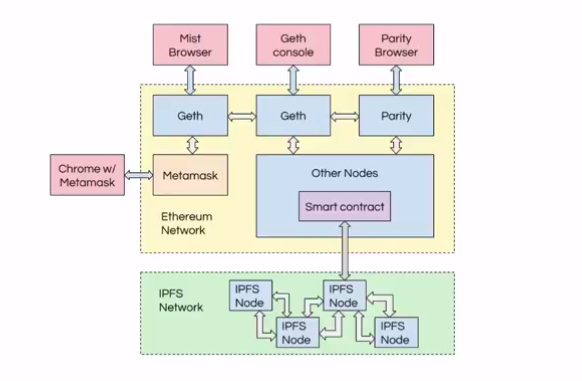-
It is important to know whether using a DApp is a good option for given project.
-
A DApp is a good choice if the project requires the following:
- The system defines digital relationships
- Application needs to by dynamic and auditable
- Central authority is not a requirement
- Transaction speed is not of vital importance
- Ethereum has several networks:
- Mainnet: This is the real ethereum network, transactions actually cost ether, additionally this is the slowest option.
- Testnets: This is used for development (typically beta tests) purposes only, ether is required for transactions but the ether is fake and therefore free.
- Private Network: Transactions are instantly processed, and cost no ether but they are also completely isolated from other networks.
- When developing applications/ smart contracts all three of these networks would ideally be utilized fo
- Phase 1 - Private Network
- Rapid setup/ depoloyment/ testing
- Phase 2 - Public Testnet
- Closely resembles production enviroment
- Test on a larger scale
- Open to the public, bug bounties can be offered
- Phase 3 - Ethereum Mainnet
- Highest amount of risk
- All transactions handle real value
- Phase 1 - Private Network
- Ethereum has many tools used to connect to public/ private blockchains
- Geth - instantiates connection to public/ private blockchain
- Good for setting up personal private network with multiple nodes
- Ganache (Truffle) - connects application to local private blockchain
- Good for setting up early stage dev enviroments
- Remix - connects to mainnet and simulates private blockchain
- Good for testing smart contracts on testnets/ setting up early stage dev enviroments
- Metamask - connects wallet to public/ private blockchain
- Good for interacting with smart contracts deployed to testnets
- Geth - instantiates connection to public/ private blockchain
- Create Account
- Fund Account - Faucets provide test ether for accounts on testnets
- Develop (Start of Testing Cycle)
- Compile - Remix/ SolC/ Truffle (framework that includes compiler)
- Sign & Deploy - Remix allows users to connect to Ethereum node and deploy contacts, Truffle offers complex multi-contract migration management
- Interact & Test (End of Testing Cycle) - Remix has functionality that allows users to transact with deployed contracts. Metamask lets users interact with deployed applications via browser extension. Truffle has a complex test automation framework baked in.
- Geth is a gateway to the ethereum network, in short Geth is a node in the blockchain network it is connected to.
- The following features are included with Geth:
- Connect to a blockchain or create one from scratch
- Create and manage accounts
- Fund accounts via mining or transafers from other accounts/ faucets
- Deploy compiled contracts
- Interact with deployed contracts
- Although Geth is very versatile it is not the recommended way to interact with the mainnet due to its complexity.
-
Parity is an Ethereum client similar to Geth, that has a built-in DApp enviroment.
-
The following features are included with Parity:
- Most of the features that are available in Geth are also baked into Partiy, in many cases Parity offers more advanced features.
- Multi-Signature wallets, smart contracts that can be controlled via different accounts
- Enables creation and importing/ exporting of keys
- Hardware and Cold-Storage electronic support
- Name Registry support
- Mist is a web3 browser that includes a wallet manager to create and manage user accounts.
- The following features are included with Mist:
- Connects to the mainnet or testnet
- Create and manage accounts
- Fund accounts via mining or transafers from other accounts/ faucets
- Compiled and deploy contracts
- Interact with deployed contracts
- Metamask is a Chrome/ Firefox browser extension that stores account addresses and enables private key signing.
- The following features are included with MetaMask:
- MetaMask connects to an Ethereum gateway that can be defined by the user.
- The extension injects the web3 object into the webpage to enable interaction with the Ethereum Gateway.
- Creating and funding accounts is very intuitive
- Remix is a web based solidity smart contract development IDE with an integrated debugger and testing enviroment.
- The following features are included with Remix:
- Comes with file explorer capable of storing multiple solidity files.
- Solidity Editor
- Useful for accessing the blockchain state
- Chat Support page
- Simulate blockchain with pre-funded accounts or connect to a live network.
- Can interact with any deployed contract.
- Truffle is a development framework for Ethereum.
- The following features are included with Truffle:
- Comes with built-in smart contract compilation. linking, deployment, and binary management.
- Built-in testing with Mocha and Chai
- External script runner
- Ganache is a part of the Truffle Developer suite.
- The following features are included with Ganache:
- Instantiates a local private blockchain that contains pre-funded accounts.
- Allows user to run tests, inspect state, and execute commands.
- Easily configured with MetaMask and Remix.
- Web3.js is a collection of Javascript libraries that allow you to easily communicate with local or remote Ethereum nodes using the HTTP or IPC connection.
- The following features are included with Web3.js:
- Abstracts away alot of the difficulty involved in interacting with a node via the JSON RPC
- Web3 has all of the functionality of the node that it connects to.
- Provides access to node functions to applications that the Web3 object is instantiated in
- IPFS and Swarm are decentralized filed storage solutions for web 3.0
- Storing large amounts of data on the blockchain are impractical! IPFS and Swarm intend on addressing this issue.
- It is possible to store references to data kept in IPFS or Swarm in smart contracts as a reference to large datasets.
